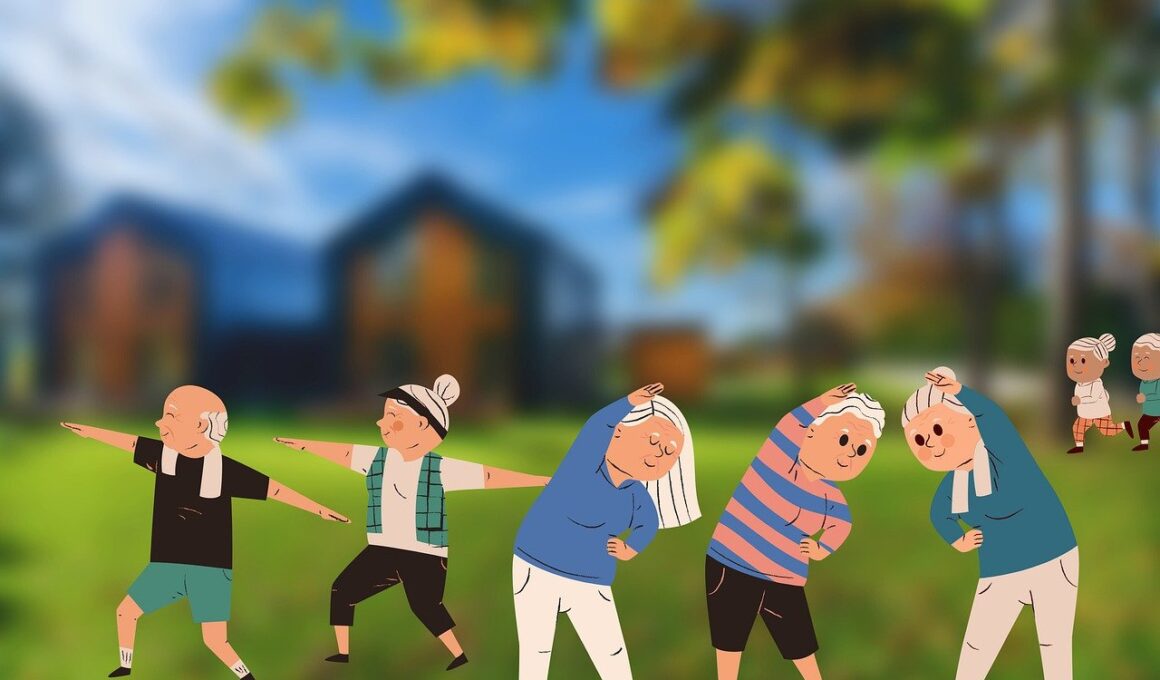Benefits of Group Fitness Classes for Older Adults’ Muscle Health
As people age, muscle mass naturally declines due to a process called sarcopenia. This condition affects various aspects of health, making it vital for older adults to maintain their muscle strength. Participating in group fitness classes can significantly reduce the risk of sarcopenia. These classes provide structured and guided workouts, which are designed specifically for older individuals. Group settings foster social connections among participants, which can enhance motivation and adherence to exercise routines. By participating in these classes, older adults can improve their cardiovascular health, enhance flexibility, and build muscle strength through resistance training. Moreover, things like the encouragement from peers and interaction with instructors can make exercising more enjoyable and less daunting. Studies indicate that regular engagement in fitness activities helps preserve muscle mass and even promotes muscle gain in individuals who may have been sedentary. Injury prevention is another benefit, as qualified instructors ensure proper techniques, thus minimizing risks of falls. Access to various equipment also allows participants to tailor their workouts according to their abilities and fitness goals, leading to better outcomes in terms of muscle health.
Incorporating strength training into fitness regimens is crucial, especially through group fitness classes. These classes often utilize body weight, resistance bands, and dumbbells, which are essential for building muscle strength and endurance. For older adults, strength training can yield impressive benefits. It helps maintain independence by improving functionality, such as standing up from a chair or lifting everyday items. Furthermore, strong muscles support joints, reducing strain and lowering the risk of injuries. In group classes, the atmosphere encourages participation, even in those who may feel intimidated by traditional gym settings. Instructors often offer modifications, making fitness accessible to everyone, regardless of starting fitness levels. Engaging in routine physical activity also contributes to overall mental wellbeing, decreasing anxiety and depression symptoms. Alongside these physical benefits, the social aspect is significant; meeting like-minded individuals fosters friendships and enhances commitment to fitness goals. The structure of group classes generally includes warm-ups, core work, and cool-downs, ensuring comprehensive muscle engagement while minimizing injury risk. This holistic approach effectively combines fun with fitness, thereby making overall health improvement sustainable.
Social Engagement and Community Support
The social element of group fitness cannot be understated for older adults. Many find themselves isolated, leading to negative mental health outcomes. Group fitness classes create opportunities for older individuals to meet regularly, fostering friendships amongst participants. This camaraderie promotes a motivational environment where everyone supports one another. Engaging with a community whose members share similar goals can be incredibly uplifting and inspire consistency in attendance. Moreover, interaction during classes encourages communication, which can improve cognitive function—a critical aspect of aging. Loneliness can contribute to health decline, making community within fitness crucial in combating these feelings. The gathered support can be instrumental in helping older adults push through challenging workouts, facilitating adaptive physical changes over time. Social gatherings post-workout can enhance these bonds, as older adults discuss their fitness journeys, share stories, or even go out for wellness-oriented activities. Additionally, group classes provide accountability, as others notice absences and often check in. This kind of peer accountability may lead to higher participation rates, resulting in consistent benefits to muscle health and overall physical condition. Social interaction within these settings immensely benefits physical and mental wellbeing.
Moreover, group fitness classes are typically designed to be fun and engaging, which makes it easier for older adults to stick with their exercise plans. Instructors often incorporate music, friendly competitions, and dynamic routines to keep the atmosphere lively and enjoyable. This enjoyment factor is paramount, particularly for individuals who may find exercise monotonous or daunting. When older adults view exercise as a joyful experience rather than a chore, they are more likely to maintain attendance and, consequently, their physical health. In addition, variety in workout formats often keeps participants excited and engaged, encouraging them to try different types of exercises that build various muscle groups. This versatility can alleviate boredom that might arise from more traditional or repetitive workout routines. The wide selection of classes—such as yoga, pilates, and circuit training—allows individuals to explore different ways of movement that suit their preferences. Enhanced motivation from engaging workouts fosters a routine that can produce long-term health benefits. Therefore, incorporating enjoyable elements into fitness can significantly impact older adults’ approach to health and wellness.
Consistency and Long-Term Benefits
Regular participation in group fitness classes can lead to improved muscle health and longevity for older adults. Establishing a consistent routine is crucial in combating age-related muscle loss. These classes help create an environment that fosters commitment to physical activity. Research shows that individuals who consistently engage in exercise, especially strength training, experience reduced muscle loss over time. Group classes strengthen not only muscles but also resilience, enabling older adults to handle various physical challenges. Over time, the body adapts to the increased physical activity, leading to better muscle mass retention and improved metabolism. This is especially important as muscle tissue inherently reduces with age. Both participants and instructors offer insights that can enhance workouts, ensuring effective training while minimizing injury risks. Since older adults may be particularly vulnerable to injuries, attending group classes enables them to learn safe exercise methods. Additionally, regular muscle engagement at any age can lead to benefits, including enhanced stamina, energy levels, and overall functionality, thereby ensuring that aging doesn’t equate to a decline in quality of life. Improved muscle health translates into greater independence and activity levels.
In conclusion, group fitness classes serve as an excellent resource for older adults facing challenges associated with sarcopenia. The social support, structured guidelines, and variety of exercises create a well-rounded fitness experience. These classes can instill confidence, encourage routine participation in physical activity, and help prevent muscle loss. The sense of belonging fostered within a group can be one of the key motivators for committing to an exercise regime. Older adults can maintain muscle strength, engage socially, and enjoy the process of fitness amidst an age-related decline. Programs tailored to their specific challenges provide the necessary support for achieving positive results. Furthermore, recognizing the importance of physical activity may inspire a lifestyle shift that prioritizes health and wellbeing. By choosing to participate, older adults not only improve their muscle health but also enrich their quality of life. Investing time in group fitness can yield profound benefits that extend beyond the gym setting, impacting relationships, everyday functionality, and overall happiness. Enhanced muscle health creates an opportunity for a more active, engaged, and fulfilling life, illustrating that age need not dictate ability or activity.
Final Thoughts
The journey towards maintaining muscle health through group fitness is a vital and rewarding endeavor for older adults. Taking the initiative to join these classes can be the first step towards achieving long-term health benefits. By fostering connections with others who share similar aspirations, individuals can enhance their motivation for regular exercise. Despite potential challenges related to age, the freedom, functionality, and joy that come from being active can be transformational. Encouragement from fitness communities further empowers participants, creating resilience as they face aging challenges together. Developing a newfound love for physical activity that promotes muscle strength can lead to fulfilling engagements. These positive experiences often inspire continued growth and learning within fitness disciplines, making every workout an opportunity for personal development. The broader implications highlight the necessity of social networks in supporting health initiatives among older adults. With the right environment, resources, and mindset, they can build a sustainable, effective fitness regime that significantly impacts muscle health. Adopting a more active lifestyle ultimately fosters better muscle retention, health preservation, and optimal aging outcomes.


